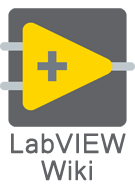Application Builder: Difference between revisions
Appearance
New page: {{TOCnestright}}<br> = Introduction<br> = The application builder (AB) is a part of the LabVIEW Project environment, it has the possibilities to distribute your code in various ways:<br>... |
Automatic build |
||
| Line 1: | Line 1: | ||
{{TOCnestright}}<br> | {{TOCnestright}}<br> | ||
= Introduction<br> = | = Introduction<br> = | ||
The application builder (AB) is a part of the LabVIEW Project environment, it has the possibilities to distribute your code in various ways:<br> | The application builder (AB) is a part of the LabVIEW Project environment, it has the possibilities to distribute your code in various ways:<br> | ||
*Executables<br> | *Executables<br> | ||
*DLLs<br> | *DLLs<br> | ||
*Source distributions<br> | *Source distributions<br> | ||
*Web services<br> | *Web services<br> | ||
*Installers<br> | *Installers<br> | ||
Depending on the LabVIEW version you have one or more of the above options might be missing.<br> | Depending on the LabVIEW version you have one or more of the above options might be missing.<br> | ||
<br> | <br> | ||
= Manual<br> = | = Manual<br> = | ||
{{Stub}}<br> | {{Stub}}<br> | ||
= Advanced<br> = | = Advanced<br> = | ||
The application builder has several interesting advanced uses | The application builder has several interesting advanced uses<br> | ||
<br> | == Automatic building<br> == | ||
= | You can use a VI inside vi.lib that can build without user interaction. The VI is located in <span style="font-style: italic;"><</span>''vi.lib>\AppBuilder\BuildTargetBuildSpecification.vi''. This VI takes a project path and optionally a build and target name as parameters.<br> | ||
Inside the application builder LabVIEW uses several symbolic paths to have envorinment dependent variables.<br> | == Symbolic paths<br> == | ||
Inside the application builder LabVIEW uses several symbolic paths to have envorinment dependent variables.<br> | |||
{| cellspacing="1" cellpadding="1" border="1" style="width: 708px; height: 104px;" | {| cellspacing="1" cellpadding="1" border="1" style="width: 708px; height: 104px;" | ||
|- | |- | ||
! scope="col" | Symbolic path<br> | ! scope="col" | Symbolic path<br> | ||
! scope="col" | Contents<br> | ! scope="col" | Contents<br> | ||
! scope="col" | Usage<br> | ! scope="col" | Usage<br> | ||
|- | |- | ||
| NI_AB_PROJECTNAME<br> | | NI_AB_PROJECTNAME<br> | ||
| Name of the project<br> | | Name of the project<br> | ||
| Automatically place the build in a folder that is named after the project<br> | | Automatically place the build in a folder that is named after the project<br> | ||
|- | |- | ||
| NI_AB_TARGETNAME<br> | | NI_AB_TARGETNAME<br> | ||
| Name of the (Real-Time) target<br> | | Name of the (Real-Time) target<br> | ||
| <br> | | <br> | ||
|} | |} | ||
<br> | <br> | ||
<br> | <br> | ||
<br> | <br> | ||
[[Category: | [[Category:Building_executables]] | ||
Revision as of 07:13, 9 August 2010
Introduction
The application builder (AB) is a part of the LabVIEW Project environment, it has the possibilities to distribute your code in various ways:
- Executables
- DLLs
- Source distributions
- Web services
- Installers
Depending on the LabVIEW version you have one or more of the above options might be missing.
Manual
| |
This article is a stub. You can help LabVIEW Wiki by expanding it. Please improve this article if you can. |
Advanced
The application builder has several interesting advanced uses
Automatic building
You can use a VI inside vi.lib that can build without user interaction. The VI is located in <vi.lib>\AppBuilder\BuildTargetBuildSpecification.vi. This VI takes a project path and optionally a build and target name as parameters.
Symbolic paths
Inside the application builder LabVIEW uses several symbolic paths to have envorinment dependent variables.
| Symbolic path |
Contents |
Usage |
|---|---|---|
| NI_AB_PROJECTNAME |
Name of the project |
Automatically place the build in a folder that is named after the project |
| NI_AB_TARGETNAME |
Name of the (Real-Time) target |
